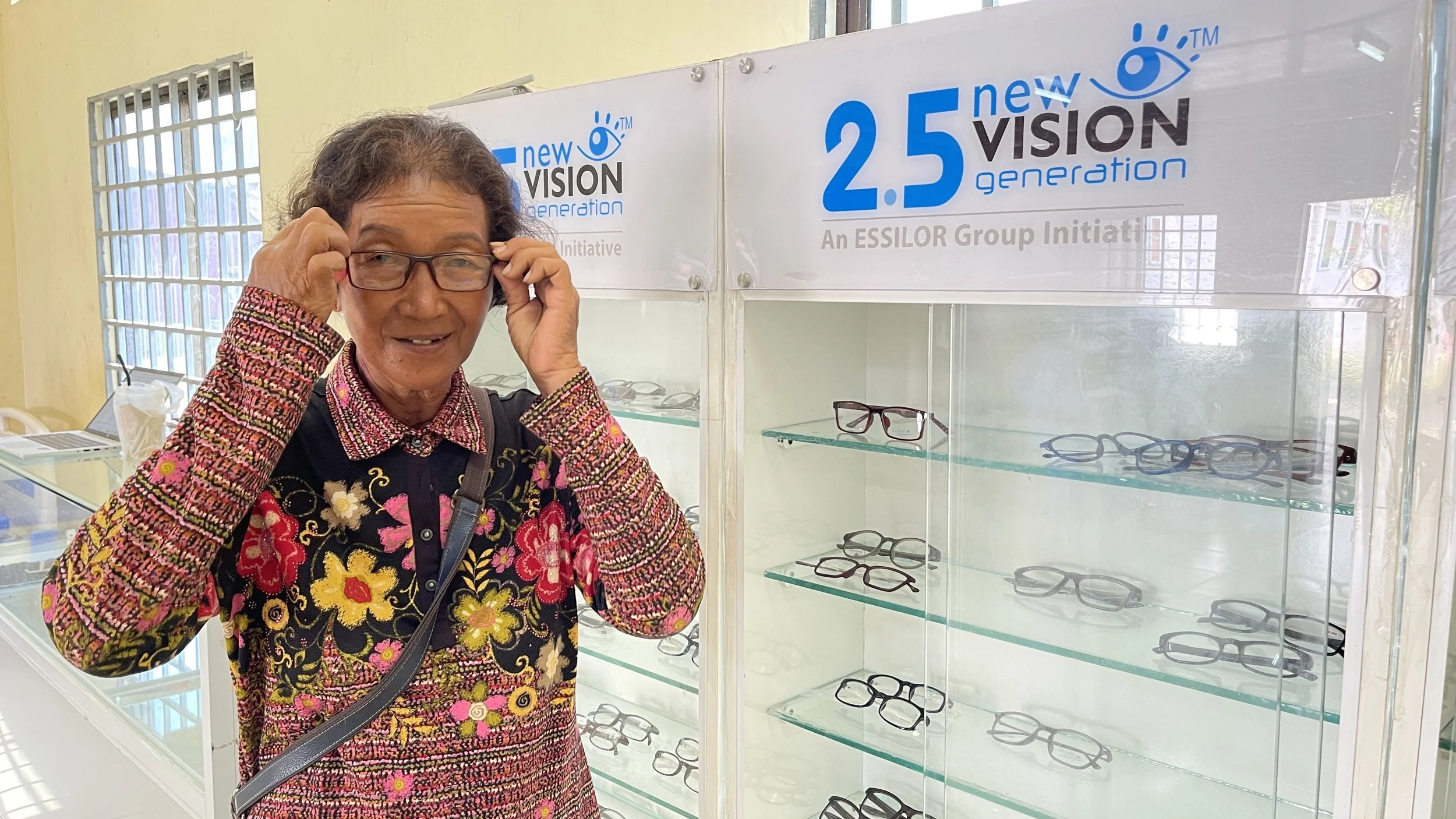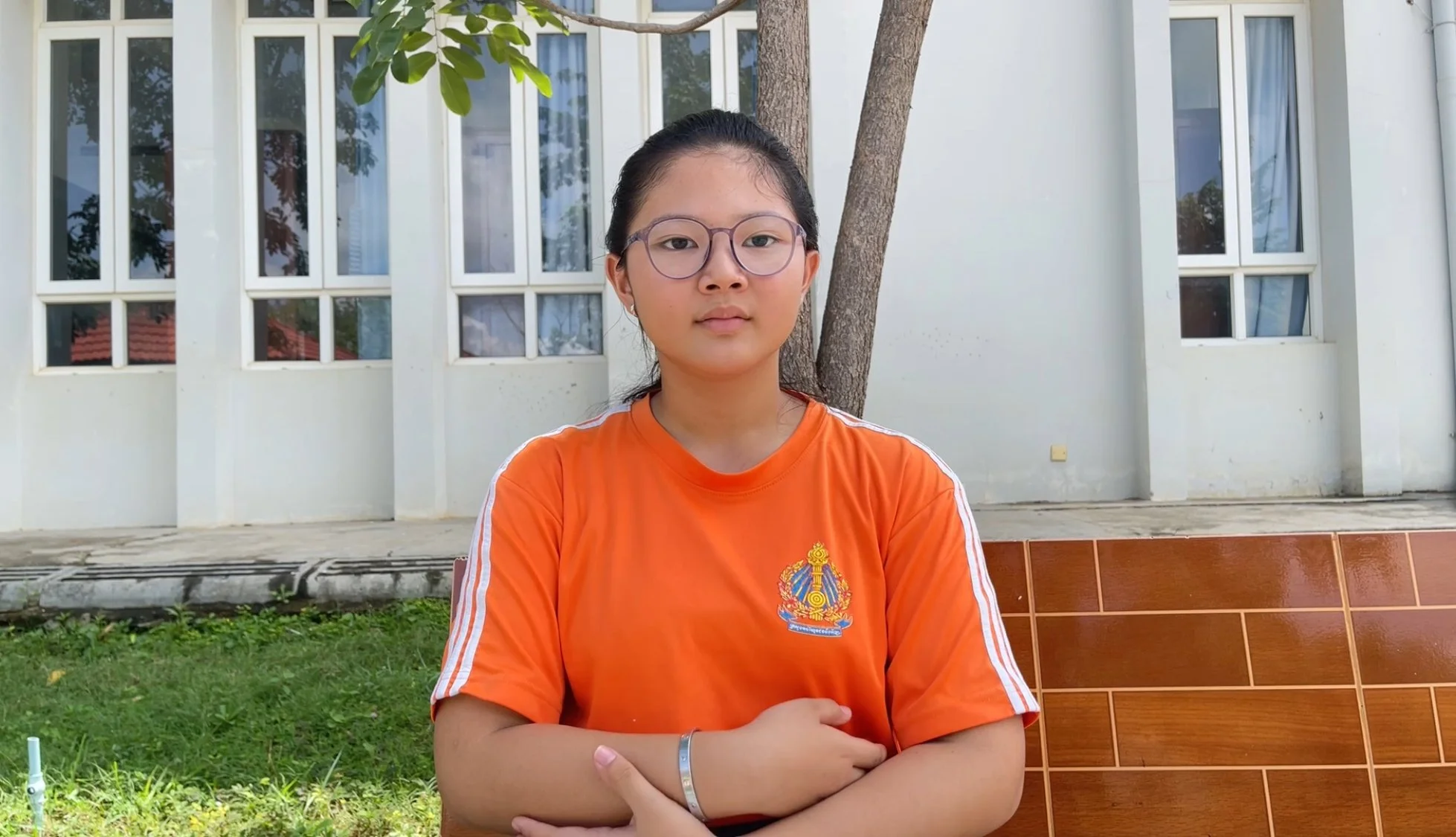Sina trying out glasses. Photo: The Fred Hollows Foundation
In Cambodia, uncorrected refractive error is the leading cause of visual impairment. Simple interventions, such as providing eyeglasses, can have a profound impact on people’s lives. Sina, a 60-year-old former tailor, experienced this firsthand. Her deteriorating eyesight forced her to abandon her tailoring work and take up manual labour on a cassava plantation.
"I was so happy when I first wore my glasses”, Sina exclaimed, after receiving the appropriate glasses from a public vision centre established by the Scaling Up Refractive Error Services Phase II (SURES-II) project. "I could see clearly for the first time. Once I returned home, I noticed a significant improvement in my vision. Everything is much clearer, and it's easier for me to travel to the field for work."
Bridging the gap in eye care access
According to the World Health Organization, over 2.2 billion people worldwide have a vision impairment, and many require assistive devices for daily living.
The lack of access to affordable assistive technology presents a significant challenge for people with visual impairments. The Fred Hollows Foundation, in partnership with the Government of Cambodia, and supported by the US government and ATscale, is working to address the issue of uncorrected refractive error, a common condition that can severely limit their ability to learn, work, and participate fully in society. So far the programme has achieved significant results, providing eye screenings and provision of eyeglasses to over 340,000 children and adults, and delivered eye health education sessions to over three million. In addition, the programme has set up public vision centres, trained local eye health professionals, and raised awareness about eye health to the general public.
Sopanhary Huy, a nurse at Choam Ksant Referral Hospital, highlights the transformative impact of these centres: "Having the vision centre here allows people to access eye care promptly. Previously, they would need to travel far to reach services in other provinces, which often meant arriving too late for necessary treatment."
Kimhor wearing her glasses. Photo: The Fred Hollows Foundation
For students like Kimhor, an 11-year-old from Kampong Speu, the impact of the SURES-II project has been life-changing. Struggling with blurry vision, Kimhor was unable to fully engage in her studies and often found herself falling behind her classmates. Her teacher, noticing her difficulties, arranged for a refractionist to visit the school and screen students for vision problems.
"Before, the letters looked like one long line all blended together," Kimhor shares. "If I didn’t have these glasses, it would still be hard for me to see the letters properly and to learn anything at school."
After receiving her glasses, Kimhor's academic performance improved dramatically. Once ranked 20th out of 22 students, she is now top of the class. "To my friends, and anyone else who thinks they might have trouble seeing - visit a vision centre or hospital near you for an eye exam! It has made such a difference for me," she encourages.
Beyond the classroom: A ripple effect
Leakna received prescription glasses and ongoing eye care. Photo: The Fred Hollows Foundation
The impact of the SURES-II project extends beyond the classroom. Leakna, a 10th-grade student from Choam Khsan District, faced similar challenges with her vision. She struggled to see objects from afar, making her journey to school dangerous and her schoolwork a constant struggle.
"My vision started getting worse, so my mother decided to take me to Choam Ksan referral hospital for an eye examination," says Leakna.
With the support of The Fred Hollows Foundation, Leakna received prescription glasses and ongoing eye care. Her life has improved significantly. She is more confident, her grades have improved, and she has become an advocate for eye health among her peers.
"I told my classmates that I got the eyeglasses free of charge because the hospital policy declared that all students are entitled to get prescription glasses for free in Choam Ksan Public Vision Centre," she said.
Building sustainable eye care systems
A key strategy in tackling refractive error in Cambodia has been investing in eye health staff. The SURES-II project has trained over 1,000 eye health professionals and teachers, ensuring that quality refractive error services are available for many more people. Dr Leng Kim Chheang, Acting Director of Choam Ksant Referral Hospital, emphasized the importance of this training,: "To ensure that the public vision centre operates effectively, it is important to train primary care service providers in our hospital. This includes equipping them with adequate refractive error clinical equipment, along with other necessary apparatus."
To ensure long-term sustainability, the project in Cambodia is deeply integrated with national systems, working collaboratively with both the public and private sectors to create lasting impact. A key aspect of this effort is strong engagement with the National Program for Eye Health (NEPH) in Cambodia, reinforcing the government's role in expanding and maintaining eye care services.
The project also focuses on policy development across multiple areas, including private sector regulation, integrating eyeglass provision into the government's Health Equity Fund (HEF) system, and incorporating eye health into the school health curriculum. Additionally, by training healthcare professionals, the initiative strengthens the capacity of local health systems, ensuring that quality refractive error services remain accessible well into the future. Furthermore, the establishment of public vision centres inside/within hospital premises, with the government supporting the infrastructure and the project supporting the service delivery component, follows a shared responsibility model, promoting ownership and also contributing to sustainability.
Call to action
The need for accessible eye care and assistive technology is not unique to Cambodia. Globally, millions of people suffer from visual impairment due to uncorrected refractive error and other eye conditions. The World Health Organization estimates that 1 billion people worldwide could have their vision prevented or corrected with access to proper eye care.
“The stories of Sina, Lida, Kimhor, and others highlight the urgent need for continued investment in eye health programmes and assistive technology,” said Pascal Bijleveld, CEO of ATscale. “By supporting initiatives like the SURES-II project and advocating for policies that prioritize eye health, we can create a world where everyone has the opportunity to see clearly and live a life free from preventable vision impairment”.
More on our work in Cambodia.
Catalytic funding set to increase access to assistive technology for 275,000 Cambodians by 2025



